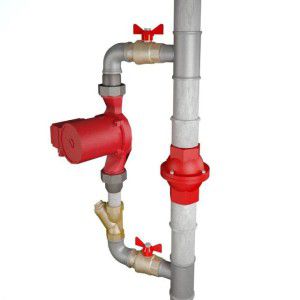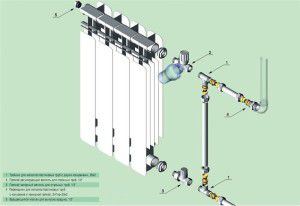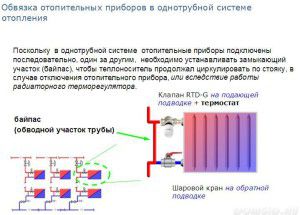A professional approach to creating a heating circuit differs not only in accurate calculations, but also in the use of all means to improve the system. For this, the individual characteristics of the building, the climatic features of the region and, of course, the level of service comfort are taken into account. An important function in the general scheme is performed bypass in the heating system: the purpose, calculation, diameter of this element is mandatory not only when creating a new main, but also when upgrading the old one.
The purpose of the bypass in the heating system
What is the bypass in the heating system for and what functions should it perform? Its general purpose is the formation of a parallel flow bypassing the heating components (radiators, valves, circulation pumps). It is a highway connecting conditional input output branch pipes of a specific element of the system.
It can perform several functions. For example, a bypass in the heating system of a multi-storey building is necessary for repair or maintenance work. This is especially true for replacing radiators during the heating season. With it, you can redirect the flow of coolant to bypass the battery.
In addition, the parallel transport highway performs the following functions:
- Adjustment of the heat carrier flow to the radiator. By installing the appropriate component (thermal head), you can automatically reduce (increase) the volume of hot water in the battery;
- Circuit upgrade - Another purpose of the bypass in the heating system. This primarily refers to single-tube schemes in which without this element it is impossible to change the level of water flow in the radiator;
- Creating universal heating. When the power is turned off, the blades of the circulation pump will make the gravitational movement of fluid in the pipes practically impossible. But why do we need a bypass in the heating system in this case? With its help, a bypass channel is created in which the hydraulic resistance does not interfere with the natural circulation of water.
At first glance, to install an additional channel, only a pipe of the correct shape will be required. But without the right components, it will not function properly. To do this, it is necessary to correctly calculate the bypass diameter in the heating system, install shut-off valves. With its help, you can redirect the fluid flow bypassing a specific component of the system or exclude the movement of water along the bypass.
When installing plastic pipes as a bypass in a steel line, the degree of its thermal expansion must be taken into account.
Bypass Installation
Knowing how the bypass in the heating system works and why it is needed - you can go to specific examples. Most often, it can be found in single-pipe schemes of multi-storey buildings. But besides this, it is universally used in autonomous systems of private houses. For proper installation, it is necessary to calculate the bypass of the heating and select the accessories for it.
Radiator bypass
The organization of the bypass channel in the radiator harness is done not only in single-pipe, but also in two-pipe schemes. With its help, it is possible to regulate the flow of coolant and carry out repair and maintenance work without stopping the boiler or disconnecting from central heating.
How to bypass the heating system yourself? First, you should carry out preliminary calculations and choose the right components.It is recommended to use pipes of the same material as for the entire line. The difference will only be in cross section. The bypass diameter in the heating system must be 1 size smaller than the cross section of the main pipe.
Before self-installation, you should familiarize yourself with the following recommendations:
- Ball valves must be installed as shut-off (shut-off) valves. With their help, you can quickly redirect the coolant to bypass;
- Mounting the mixing valve is not rational. It effectively mixes cold and hot water in collector systems, where the coolant flow rate is initially normalized. For pipelines, and even more so for central heating, this is impossible to achieve;
- Arrangement of a bypass in a single-pipe heating system is mandatory. It is important to pre-coordinate the installation with the management company.
Consumables are purchased for the installation of a parallel pipeline. Consider the example of a metal-plastic line the optimal set of components. What is the bypass in the heating system for in this case? It will act as a bypass circuit to repair or replace the radiator, and to regulate the flow of water in the battery section. First, the distance between the direct and return pipes of the radiator is measured. Before bypassing the heating system, the pipe is cut to the dimensions obtained. The most common pipe size in autonomous heating is ½. Based on this, components will be selected whose characteristics and cost are presented in the table.
| Name | price, rub. | Qty | Amount |
| Metal-plastic pipe, mp | 23 | 0.5 m | 12 |
| Tee | 75 | 2 pcs. | 150 |
| Male thread adapter | 50 | 2 pcs. | 100 |
| Control valve | 448 | 1 PC. | 448 |
| Ball valve | 137 | 2 pcs. | 274 |
| Total | 984 | ||
Before the bypass in the heating system works, you should check the reliability of all connections. For this, crimping of this section of the pipeline is carried out, preferably hydraulically. Only then can the pipes be filled with coolant.
To install a bypass in the heating system of a multi-storey building, you must first shut off the riser to which the radiator is connected. Only representatives of the management company can do this.
Bypass for installing a circulation pump
Unlike radiator piping, the purpose of the bypass in a forced-type heating system is to minimize hydraulic losses. For this, the pump is not installed on the return pipe, but directly on the bypass.
What is the bypass in the heating system in this case? It performs the same functions as when binding the radiator. Distinctive is the installation of a check valve on the pipe. It is necessary to prevent a change in the direction of flow of the coolant when the pump is turned off.
In addition, during installation, you need to consider such features:
- Without a doubt, a bypass is required in an autonomous heating system with forced circulation. Without it, when the power is turned off, the speed of the coolant will sharply decrease;
- The optimum diameter of the bypass in the heating system for pump strapping is 2 sizes smaller than the cross section of the main pipe;
- A strainer is installed in front of the pump to prevent debris from entering its mechanism.
It is advisable to use ball valves as shutoff valves. In this circuit node, a smooth adjustment of the coolant volume is not needed. Most often, it is required to quickly shut off its flow to replace or repair equipment.
The calculation of the pump in the heating bypass is performed not by the cross-section of the bypass pipe, but by the diameter of the main line.
Bypass in central heating system
The purpose of the bypass in the single-pipe heating system of a multi-storey building is the ability to carry out repair work with a radiator without disconnecting the central riser. To do this, the valves are closed and the battery is actually disconnected from the common system without stopping the coolant in the main.
The principle of installing a bypass in a single-pipe heating circuit is almost completely identical to that for the described autonomous one. The difference lies in the features of the operation of centralized systems, namely:
- In the absence of a bypass highway, it can only be installed with the permission of the management company;
- When choosing materials and components, it is necessary to take into account possible hydraulic shocks characteristic of central heating;
- Installing a thermostat will reduce the heat transfer of the battery in case of increased room temperature. Alas, the reverse process is not possible - the operation of the bypass in the heating system can only reduce the flow of coolant, but not increase it.
If there is a likelihood of a low level of coolant in the batteries - you need to install shut-off valves on the bypass. Thus, the entire flow of hot water can be redirected along the circuit with the radiator.
If you make a bypass in a central heating system without a ball valve and a thermostat, the volume of coolant inflow into the battery will decrease by 20-30%.
To reduce the complexity of the work, it is recommended to purchase ready-made workarounds. But before that, you need to do all the calculations for installing a bypass in the heating system - the optimal diameter, a set of accessories, etc. If there are no ready-made designs with the necessary parameters, you can do it yourself. The most optimal option is to make a bypass in the heating system from metal-plastic.
The video shows the functional features of the bypass in the heating system:







